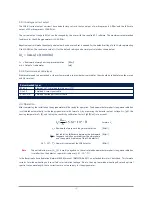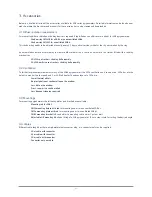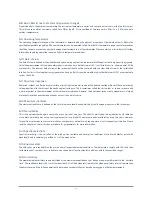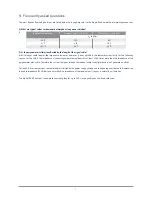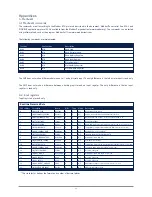
6.3 Response time
Any measuring device requires a certain time to react to a change in the parameter being measured. The radiometer requires
time to respond to change in the incident radiation. The response time is normally quoted as the time for the output to reach
95% (sometimes 63%) of the final value following a step-change in irradiance. It is determined by the physical properties of the
thermopile and the radiometer construction. SGR series pyrgeometers have a fast response, which makes them suitable for
measuring far infrared radiation (FIR) under variable weather conditions.
6.4 Non-linearity
The non-linearity of a pyrgeometer is the percentage deviation in the sensitivity over a net irradiance range from -250 to +250 W/m²
compared to the sensitivity calibration irradiance of -100 W/m². The non-linearity effect is due to convective and radiative heat
losses at the black absorber surface which make the conditional thermal equilibrium of the radiometer non-linear.
6.5 Temperature dependence
The sensitivity change of the pyrgeometer with ambient temperature is related to the thermodynamics of the radiometer
construction. For the SGR3 this dependency is measured for a large series of instruments and the average dependency is corrected
by the Smart Interface. This gives the SGR3 a better temperature performance than the CGR3.
For every SGR4 the temperature dependency is individually measured and corrected. This correction is over a range of -40 to +70°C.
The corrected value is available via the analogue and digital outputs.
6.6 Tilt error
This is the deviation from the sensitivity at 0° tilt (exactly horizontal) over the range from 0° to 90° tilt. The tilt response is
proportional to the incident radiation. The error could be corrected for, in applications where it is necessary to install the
pyrgeometer on an inclined surface, but is usually insignificant.
6.7 Window heating o
ff
set
Currently the major source of error concerning common pyrgeometer measurements is caused by the so-called ‘window heating
offset’. When a pyrgeometer is exposed to the sun, heating of the silicon window occurs due to absorption of solar radiation by the
material. As a consequence the window of most types of pyrgeometer will heat up proportionally to the solar irradiance.
The resulting temperature difference between window and thermopile will cause heat transfer by radiation and convection to the
sensor. This affects the net thermal radiation as measured by the thermopile and is commonly referred to as the ‘window heating
offset’. The result is measurement of a too high value for downward long-wave radiation.
This offset is not easily reduced by ventilation, which only cools off 50 W/m²/°C at maximum while solar radiation can be
absorbed at a rate of about 500 W/m² on a sunny day. Currently certain types of pyrgeometers are equipped with one or more
thermistors to measure the window absolute temperature that represents the apparent offset. A complex calculation must be
performed to eliminate the offset.
The SGR4 has a unique designed construction that minimizes the window heating by conducting the heat into the housing.
Temperature variations between window and detector are less than 0.3°C, compared with up to 3°C for other types of pyrgeome-
ters. In SGR 4 the window heating offset is less than 4 W/m². This allows accurate daytime measurements, even in full sunlight,
without the need for a tracking shading disk.
30



